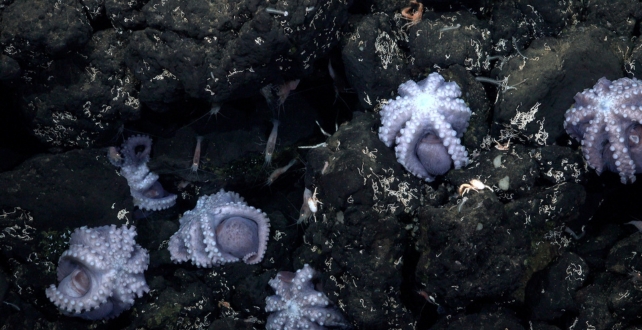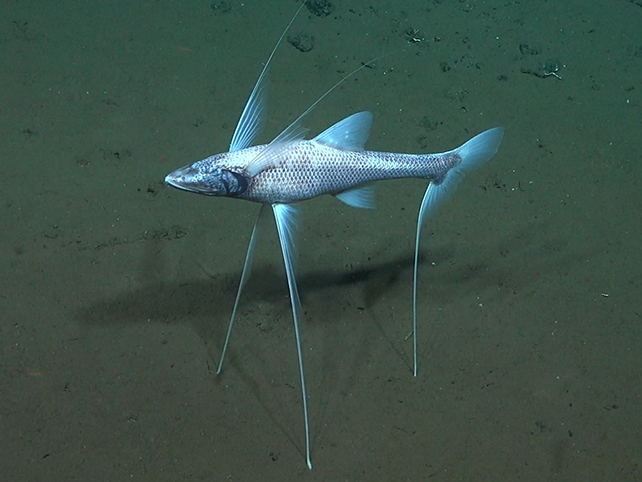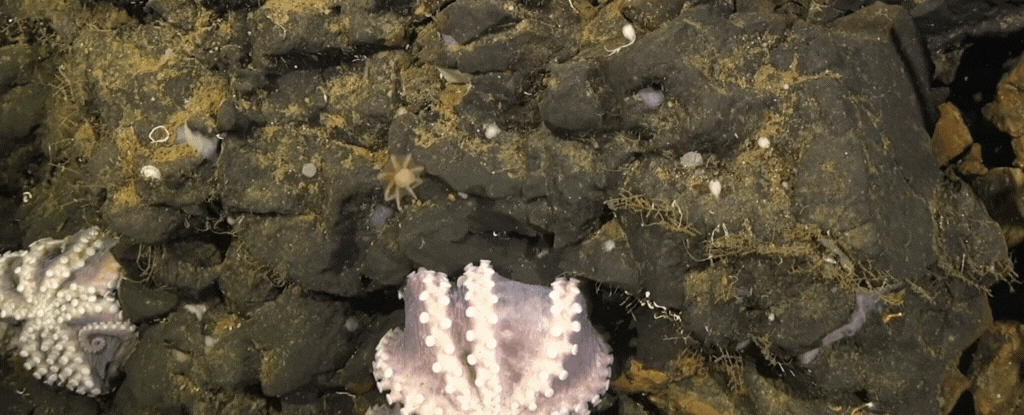Scientists have found a new octopus nursery in seamounts off the coast of Costa Rica and confirmed a previously discovered one in the area is active, bringing the world's known octopus nurseries to a total of three.
Incredible footage shows babies hatching, mothers protecting their young from predators, and even a potentially new octopus species.
The 18 international scientists aboard the Schmidt Ocean Institute's Falkor research ship witnessed the breathtaking scenes via an underwater camera on a remotely operated vehicle during a recent expedition.
"The discovery of a new active octopus nursery over 2,800 meters [nearly 9,200 feet] beneath the sea surface in Costa Rican waters proves there is still so much to learn about our ocean," says physical oceanographer Jyotika Virmani of the Schmidt Ocean Institute.
The unnamed outcrop nursery was in an area explored for the first time, and brooding octopuses were found around low-temperature hydrothermal vents at around 7 °C (44.6 °F).
The researchers believe they observed nursing octopuses that may be a new species in the Muusocotpus genus of octopus, that does not have ink sacs.
Deep-sea octopuses' brooding behavior is not well understood, but previous research found that one species (Graneledone boreopacifica) broods for about 53 months. Although the new species is in the Muusoctopus genus, its eggs are similar in size to those of G. boreopacifica.
"The discovery of these low-temperature vent sites is difficult and can only be found with submersible vehicles like Schmidt Ocean Institute's highly capable ROV SuBastian," explains Beth Orcutt, a geomicrobiologist from the Bigelow Laboratory for Ocean Sciences.
The original discovery of the Dorado Outcrop nursery caused quite a stir. An estimated one hundred female octopuses were seen brooding near hydrothermal vents on the Pacific Ocean seafloor off Costa Rica, the first time scientists had ever seen female octopuses congregating to brood their eggs.
And in 2018, the Davidson Seamount off California's coast was confirmed to have the largest deep-sea octopus nursery ever discovered.
But no developing embryos were seen at the Dorado Outcrop, and researchers thought the area was too warm for them to produce viable offspring.
Now, their doubts have been put to rest after scientists had the incredible opportunity to witness the babies hatching.

The expedition didn't stop there, with the team also exploring five previously unknown seamounts in the Costa Rican waters.
Amazing marine life can often be found near seamounts, shallow areas surrounded by steep slopes, protruding from the seafloor. Large amounts of fluid move beneath the seafloor between these 'underwater mountains', which influences tides and chemical fluxes between the Ocean and the Earth.
The Costa Rican government has protected some of the seamounts off its coast, but others, particularly those along the northwest edge of the Pacific Ocean, have received less attention.

These seamounts turned out to be teeming with life, with hundreds of animals, many of them – like the weird tripod fish in the image above – expected to be new species. It's like the scientists stumbled upon a hidden treasure trove of biodiversity.
"The information, samples, and images are important to Costa Rica to show its richness and will be used for scientific studies, and outreach," says marine biologist Jorge Cortes of the University of Costa Rica, "to raise awareness of what we have and why we should protect it."
"The deep-sea off Costa Rica rides the edge of human imagination, with spectacular footage collected by ROV SuBastian of tripod fish, octopus hatchlings, and coral gardens," says Virmani.
"We look forward to continuing to help the world witness and study the wonders of our incredible ocean."
